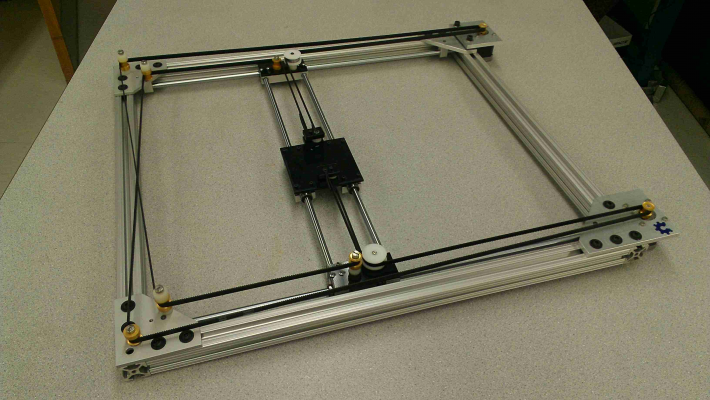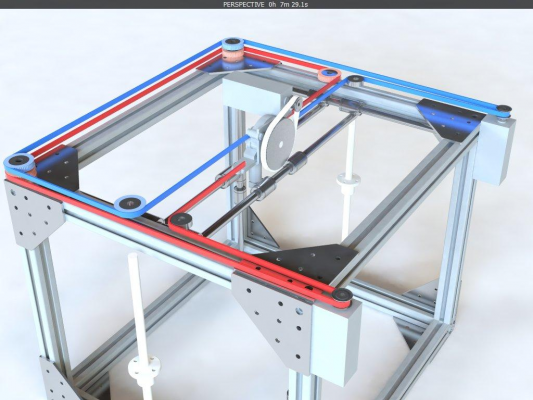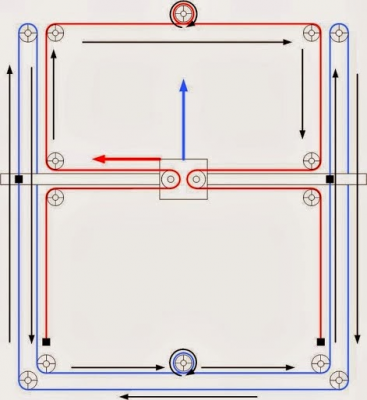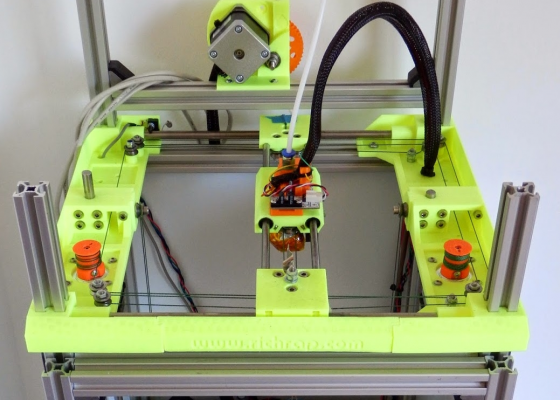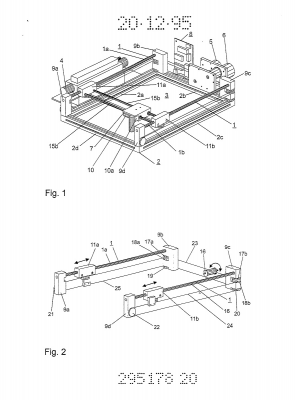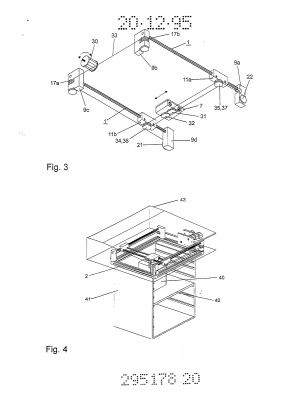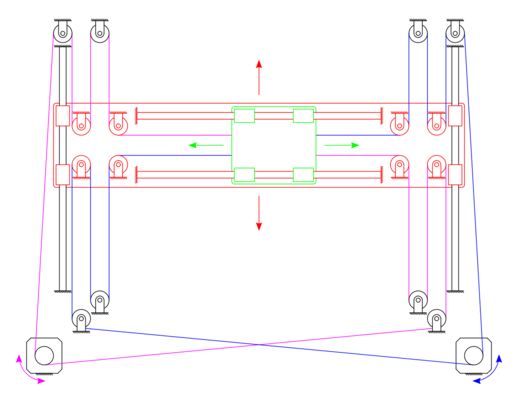corexy vs non-intersecting corexy: does it make any difference when used with spectra/kevlar line?
Posted by realthor
|
corexy vs non-intersecting corexy: does it make any difference when used with spectra/kevlar line? July 22, 2015 05:14AM |
Registered: 9 years ago Posts: 1,035 |
Hi guys, I was studying a bit the coreXY/coreXZ with spectra line, and I was quite surprised to learn about another option to the common one, either the intersecting type or the 2-planes variation, the non-intersecting.
The two types of common CoreXY I know of are the ones below:
Intersecting:
Non-Intersecting
===========================
There is another non-intersecting type of CoreXY for which there are several in the wild, the most known of which I guess is RichRap's Sli3DR.
I am curious if this newcomer has any advantage/disadvantage over the non-intersecting type above, mainly concerning spectra line. From what I can see it seems that the length of line in the latter is greater than the length in the first, which would be no real issue with spectra but maybe more costly for timebelts. The other thing is stepper positioning, for the common type the steppers are placed at the corners of the gantry on a single side while for this new type the steppers have to be in the middle of the sides, on two different sides, which makes it more messy I guess.
Thank you.
Edited 4 time(s). Last edit at 07/22/2015 08:26AM by realthor.
RepRap Lander concept on Concept Forge
RepRap Lander concept on RepRap Forums
My Things, mostly experimental stuff
The two types of common CoreXY I know of are the ones below:
Intersecting:
Non-Intersecting
===========================
There is another non-intersecting type of CoreXY for which there are several in the wild, the most known of which I guess is RichRap's Sli3DR.
I am curious if this newcomer has any advantage/disadvantage over the non-intersecting type above, mainly concerning spectra line. From what I can see it seems that the length of line in the latter is greater than the length in the first, which would be no real issue with spectra but maybe more costly for timebelts. The other thing is stepper positioning, for the common type the steppers are placed at the corners of the gantry on a single side while for this new type the steppers have to be in the middle of the sides, on two different sides, which makes it more messy I guess.
Thank you.
Edited 4 time(s). Last edit at 07/22/2015 08:26AM by realthor.
RepRap Lander concept on Concept Forge
RepRap Lander concept on RepRap Forums
My Things, mostly experimental stuff
|
Re: corexy vs non-intersecting corexy: does it make any difference when used with spectra/kevlar line? July 22, 2015 10:29AM |
Registered: 9 years ago Posts: 346 |
As for intersecting or not intersecting (or in different planes as it is also called) - For a spectra line I would go for different planes because the spectra lines is so thin that the difference will be just ~4 mm ish apart.
My belt driven coreXY is on the same plane (intersecting). For belts you need to separate the planes by the belt width plus a small gap.This makes the carriage part a little more complicated but the idlers simpler. At the end of the day I think it comes out to the same and to aesthetics preferences..... There has been some posting recently promoting different planes as the best in the world but I fail to see the obvious advantage.
The last option (Sli3DR) is just a geared CoreXY. By running the belt like that you get double the steps per mm. I do not know why you would want to do that on a coreXY printer [1]. Maybe if you were making a CNC or wanted to use different steppers (with higher step then 1.8 deg) or BLDC (servo motors).
[1]: Understand that when I say " do not know" I am not being sarcastic. It is because I do not know enough to make up my mind if it is good or bad (and never tried it). It is a lot more complicated and steppers have to run a lot faster to make the same moves which can be good and bad. Belt elasticity becomes even more of a problem but maybe shock absorption (from making jerk move) will be better. If it your first CoreXY I would not do it.
My belt driven coreXY is on the same plane (intersecting). For belts you need to separate the planes by the belt width plus a small gap.This makes the carriage part a little more complicated but the idlers simpler. At the end of the day I think it comes out to the same and to aesthetics preferences..... There has been some posting recently promoting different planes as the best in the world but I fail to see the obvious advantage.
The last option (Sli3DR) is just a geared CoreXY. By running the belt like that you get double the steps per mm. I do not know why you would want to do that on a coreXY printer [1]. Maybe if you were making a CNC or wanted to use different steppers (with higher step then 1.8 deg) or BLDC (servo motors).
[1]: Understand that when I say " do not know" I am not being sarcastic. It is because I do not know enough to make up my mind if it is good or bad (and never tried it). It is a lot more complicated and steppers have to run a lot faster to make the same moves which can be good and bad. Belt elasticity becomes even more of a problem but maybe shock absorption (from making jerk move) will be better. If it your first CoreXY I would not do it.
|
Re: corexy vs non-intersecting corexy: does it make any difference when used with spectra/kevlar line? July 22, 2015 11:21AM |
Registered: 9 years ago Posts: 1,035 |
I was actually pretty impressed by this buid that i stumbled upon while doing my research.
Is it geared because of the number of pulleys the cable passes over? And if so, doubling the resolution on a corexy is bad how? Too fine resolution? How does one calculate the resolution with spectra.
Sorry, too many questions
RepRap Lander concept on Concept Forge
RepRap Lander concept on RepRap Forums
My Things, mostly experimental stuff
Is it geared because of the number of pulleys the cable passes over? And if so, doubling the resolution on a corexy is bad how? Too fine resolution? How does one calculate the resolution with spectra.
Sorry, too many questions

RepRap Lander concept on Concept Forge
RepRap Lander concept on RepRap Forums
My Things, mostly experimental stuff
|
Re: corexy vs non-intersecting corexy: does it make any difference when used with spectra/kevlar line? July 22, 2015 11:26AM |
Registered: 8 years ago Posts: 49 |
I haven't built a CoreXY (yet) but it is my next project and I've done a fair amount of looking into these things.
Sli3DR uses a Dualwire-Gantry system, which is not quite the same thing as a CoreXY. IMO the DW-G has a couple of disadvantages relative to CoreXY: (1) It uses a much larger belt or wire, so it is more susceptible to stretching and hysteresis in the belt, (2) It does not actually eliminate racking moments, and (3) I believe the X-axis is a 2:1 purchase system (am I wrong about that?) which is a little unnecessary and awkward.
The non-intersecting CoreXY also has the disadvantage that it doesn't totally eliminate racking forces either, though I imagine the moments are exceedingly small. And it really is an intersecting design, it just moves the crossover to a different location and offers little if any real advantage IMO to the standard CoreXY layout with the belts kept in plane.
My plan (so far) is to arrange the idlers to use belts, keep them in-plane, and arrange the pitch axis of the belts to be in line on their way to the carriage, just because I can and because that's about as anal-retentive as you can be when it comes to racking moments.
Sli3DR uses a Dualwire-Gantry system, which is not quite the same thing as a CoreXY. IMO the DW-G has a couple of disadvantages relative to CoreXY: (1) It uses a much larger belt or wire, so it is more susceptible to stretching and hysteresis in the belt, (2) It does not actually eliminate racking moments, and (3) I believe the X-axis is a 2:1 purchase system (am I wrong about that?) which is a little unnecessary and awkward.
The non-intersecting CoreXY also has the disadvantage that it doesn't totally eliminate racking forces either, though I imagine the moments are exceedingly small. And it really is an intersecting design, it just moves the crossover to a different location and offers little if any real advantage IMO to the standard CoreXY layout with the belts kept in plane.
My plan (so far) is to arrange the idlers to use belts, keep them in-plane, and arrange the pitch axis of the belts to be in line on their way to the carriage, just because I can and because that's about as anal-retentive as you can be when it comes to racking moments.
|
Re: corexy vs non-intersecting corexy: does it make any difference when used with spectra/kevlar line? July 22, 2015 12:00PM |
Admin Registered: 16 years ago Posts: 13,886 |
... this CoreXY-designs aren't really new -- I've built one of this 'nonintersecting' CoreXY with steel-wires back in 1994 for my first CO2-laserplotters and filed an IP in Germany to test this IP-properties-thingy ... but it's open now.
Attached the main images from the IP document, showing the assembly and separated axes for clarifying ... the 'tower-design' was sort of preparing for 3D-LOM-printing, without stating this in the files
Viktor
--------
Aufruf zum Projekt "Müll-freie Meere" - [reprap.org] -- Deutsche Facebook-Gruppe - [www.facebook.com]
Call for the project "garbage-free seas" - [reprap.org]
Attached the main images from the IP document, showing the assembly and separated axes for clarifying ... the 'tower-design' was sort of preparing for 3D-LOM-printing, without stating this in the files

Viktor
--------
Aufruf zum Projekt "Müll-freie Meere" - [reprap.org] -- Deutsche Facebook-Gruppe - [www.facebook.com]
Call for the project "garbage-free seas" - [reprap.org]
|
Re: corexy vs non-intersecting corexy: does it make any difference when used with spectra/kevlar line? July 22, 2015 01:01PM |
Registered: 9 years ago Posts: 346 |
My apologies for confusing the slicer with a geared corexy
I assumed that it was the same concept as this [forums.reprap.org]
By Nicholas
That is a geared in the way that the pulley combination halves the movement compared to a normal setup.
On the slicer the ratio of movement looks to me to be like the core.
Higher resolution on movement is not unconditionally good due to belt elasticity and speed of steppers etc.
I assumed that it was the same concept as this [forums.reprap.org]
By Nicholas
That is a geared in the way that the pulley combination halves the movement compared to a normal setup.
On the slicer the ratio of movement looks to me to be like the core.
Higher resolution on movement is not unconditionally good due to belt elasticity and speed of steppers etc.
|
Re: corexy vs non-intersecting corexy: does it make any difference when used with spectra/kevlar line? July 22, 2015 02:22PM |
Registered: 9 years ago Posts: 1,035 |
Yes, I was surprised about that cause I wasn't seeing any pulley multiplication but I don't have such a good eye for this either. In the coreXZ yes there is a compound pulley system that doubles the resolution on the axes. I am also quite surprised that the latter coreXY with the separate loops doesn't come, seemingly, with any advantage over the previous designs. Not quite evolutionary I would say, unfortunately.
For me the intersecting coreXY with spectra is the best in terms of cost and what a cartesian printer can offer. Are there any improvements on the design anywhere? I don't quite see what can be improved but again I have an untrained eye in this area.
When I look at what the industry claims best in FDM with regards to coreXY I see other points that are being improved on rather than the principle itself. As of today, one of the latest coreXY commercial 3d printers is Axiom from Airwolf3d. At least that's what google brings up in searches. Nothing very unusual or that the others competitors don't also claim.
Edited 2 time(s). Last edit at 07/22/2015 02:41PM by realthor.
RepRap Lander concept on Concept Forge
RepRap Lander concept on RepRap Forums
My Things, mostly experimental stuff
For me the intersecting coreXY with spectra is the best in terms of cost and what a cartesian printer can offer. Are there any improvements on the design anywhere? I don't quite see what can be improved but again I have an untrained eye in this area.
When I look at what the industry claims best in FDM with regards to coreXY I see other points that are being improved on rather than the principle itself. As of today, one of the latest coreXY commercial 3d printers is Axiom from Airwolf3d. At least that's what google brings up in searches. Nothing very unusual or that the others competitors don't also claim.
Edited 2 time(s). Last edit at 07/22/2015 02:41PM by realthor.
RepRap Lander concept on Concept Forge
RepRap Lander concept on RepRap Forums
My Things, mostly experimental stuff
|
Re: corexy vs non-intersecting corexy: does it make any difference when used with spectra/kevlar line? July 22, 2015 02:33PM |
Registered: 8 years ago Posts: 49 |
|
Re: corexy vs non-intersecting corexy: does it make any difference when used with spectra/kevlar line? July 23, 2015 05:45AM |
Registered: 9 years ago Posts: 4,977 |
Quote
wfcook
I don't see any purchase in the normal CoreXY setup. It seems to be a 1:1 system, only for the pruposes of calculating stepper moves the axes have been rotated 45 degrees.
45° and 1/sqrt(2) ratio. Motors needs less force but higher speed.
Also the forces are good to make the X and Y-axis orthogonal. Isn't this enough?

| Triffid Hunter's Calibration Guide | --> X <-- Drill for new Monitor | Most important Gcode. |
|
Re: corexy vs non-intersecting corexy: does it make any difference when used with spectra/kevlar line? July 23, 2015 08:21AM |
Registered: 8 years ago Posts: 49 |
Quote
Wurstnase
Quote
wfcook
I don't see any purchase in the normal CoreXY setup. It seems to be a 1:1 system, only for the pruposes of calculating stepper moves the axes have been rotated 45 degrees.
45° and 1/sqrt(2) ratio. Motors needs less force but higher speed.
Also the forces are good to make the X and Y-axis orthogonal. Isn't this enough?
Of course. I wasn't thinking it through all the way. Each individual belt is 1:1 as an isolated system but they do work in tandem. Thanks.
|
Re: corexy vs non-intersecting corexy: does it make any difference when used with spectra/kevlar line? July 23, 2015 09:59AM |
Registered: 9 years ago Posts: 1,035 |
We are talking about the normal CoreXY not the DualWire type right? It seems that normal corexy is still superior after all.
RepRap Lander concept on Concept Forge
RepRap Lander concept on RepRap Forums
My Things, mostly experimental stuff
RepRap Lander concept on Concept Forge
RepRap Lander concept on RepRap Forums
My Things, mostly experimental stuff
|
Re: corexy vs non-intersecting corexy: does it make any difference when used with spectra/kevlar line? July 23, 2015 10:49AM |
Registered: 8 years ago Posts: 49 |
|
Re: corexy vs non-intersecting corexy: does it make any difference when used with spectra/kevlar line? July 23, 2015 03:43PM |
Registered: 9 years ago Posts: 1,035 |
Yes of course I get that, I was actually summing the general consensus on this thread and others. I believe that a well built machine will perform the same with all variations of corexy as I see many successful incarnations of all these variations. It is so simple and easy to understand that I am almost tempting into it even if I kind of sworn to rep-rap mentality, therefore thinking about and waiting/expecting a rodless, linear bearing-less, screw-less utopian corexy. 
RepRap Lander concept on Concept Forge
RepRap Lander concept on RepRap Forums
My Things, mostly experimental stuff

RepRap Lander concept on Concept Forge
RepRap Lander concept on RepRap Forums
My Things, mostly experimental stuff
|
Re: corexy vs non-intersecting corexy: does it make any difference when used with spectra/kevlar line? July 23, 2015 06:05PM |
Registered: 9 years ago Posts: 346 |
Quote
realthor
Yes of course I get that, I was actually summing the general consensus on this thread and others. I believe that a well built machine will perform the same with all variations of corexy as I see many successful incarnations of all these variations. It is so simple and easy to understand that I am almost tempting into it even if I kind of sworn to rep-rap mentality, therefore thinking about and waiting/expecting a rodless, linear bearing-less, screw-less utopian corexy.
The build I am currently working on (my 2nd CoreXY) uses small bearings (683) spring loaded to go directly on the 2020 alu profile and with a doubled belt driven z-axis. I am sure the rods could also be replaced in the z-axis if that is a high priority. I am not so sure about the Rep-rep mentality - Is bearings and 2020 extrusion allowed?
I have never build a normal cartesian printer. I have a delta printer which I have all but stopped using now because I am so happy with my CoreXY build. The system is simple and really forgiving (good prints despite all sorts of wrongs). My few difficulties have all been related to the z-axis where I started with trapezoidal screw but underestimated the need for alignment for which reason I eventually turned to belts which, after laying them double (gearing), I am really happy with now.
It seems to me that CoreXY may not be a revolutionizing concept but it sure seems like a low hanging fruit to go with that design if you want the idea of a printer in a plane.
|
Re: corexy vs non-intersecting corexy: does it make any difference when used with spectra/kevlar line? July 23, 2015 07:00PM |
Registered: 9 years ago Posts: 1,035 |
It's difficult to get how the bearings are positioned inside the plastic parts, a link to a stl would help.
The reprap is difficult at this time, because a good printer needs metal. And a lot of it. A cartesian, especially corexy is forgiving indeed and it's the best between cartesian printers.
Personally I am keen on scara and rotary 3d printers for rep-rappiness but those have their own issues like poor firmware support, difficult calibration.
BTW, what is your experience with Delta, did u built the corexy out of frustration with it? I am curious
RepRap Lander concept on Concept Forge
RepRap Lander concept on RepRap Forums
My Things, mostly experimental stuff
The reprap is difficult at this time, because a good printer needs metal. And a lot of it. A cartesian, especially corexy is forgiving indeed and it's the best between cartesian printers.
Personally I am keen on scara and rotary 3d printers for rep-rappiness but those have their own issues like poor firmware support, difficult calibration.
BTW, what is your experience with Delta, did u built the corexy out of frustration with it? I am curious

RepRap Lander concept on Concept Forge
RepRap Lander concept on RepRap Forums
My Things, mostly experimental stuff
|
Re: corexy vs non-intersecting corexy: does it make any difference when used with spectra/kevlar line? July 23, 2015 08:05PM |
Registered: 9 years ago Posts: 346 |
Yeah, it can be a little hard to see. I have not actually build the entire printer yet so I am not sure of its success. Only made the demo that I showed in the photo. That works really promising though. I actually think it can be combined with printed 2020 profiles (my existing printer that I also showed a photo of previously uses linear rods).
I pretty early decided I wanted to build more machines so I will not say that I did it out of frustration. I opted for CoreXY because I wanted something different and.... Admittedly I am one of those dreamers who started out thinking I could build a CoreXY that could do everything in a single printer (CNC, laser, etc.). I still want to have those machines but now it will be different builds.
I was and am very frustrated with my Delta. This Chinese kit has not been fun and having to keep it above water to print replacement parts have been a battle. Then all the calibrations issues (many my own misunderstandings). Then all the jamming in the cheap Chinese hotend - And all that combined with many electronic problems. - edit: just leaned in the delta fórum that another builder also have struggled and never really solved that. Probably design flaw...
My first CoreXY is made out of mostly simple printed parts because I could not expect that I would be able to print anything complicated with my Delta. Actually on the Delta I have mostly fixed all the issues now, just remains one very big one with the magnetic joints disconnecting occasionally. It can print fine most of the time but my CoreXY prints fine all the time so I use that.
I have discussed the Delta vs Cartesian here on the forum before. And I think my personal conclusion of that was that my experience can not be generalized to the Deltas as a group and that especially the good Delta kits performs very nice.
Edited 1 time(s). Last edit at 07/24/2015 06:15AM by LarsK.
I pretty early decided I wanted to build more machines so I will not say that I did it out of frustration. I opted for CoreXY because I wanted something different and.... Admittedly I am one of those dreamers who started out thinking I could build a CoreXY that could do everything in a single printer (CNC, laser, etc.). I still want to have those machines but now it will be different builds.
I was and am very frustrated with my Delta. This Chinese kit has not been fun and having to keep it above water to print replacement parts have been a battle. Then all the calibrations issues (many my own misunderstandings). Then all the jamming in the cheap Chinese hotend - And all that combined with many electronic problems. - edit: just leaned in the delta fórum that another builder also have struggled and never really solved that. Probably design flaw...
My first CoreXY is made out of mostly simple printed parts because I could not expect that I would be able to print anything complicated with my Delta. Actually on the Delta I have mostly fixed all the issues now, just remains one very big one with the magnetic joints disconnecting occasionally. It can print fine most of the time but my CoreXY prints fine all the time so I use that.
I have discussed the Delta vs Cartesian here on the forum before. And I think my personal conclusion of that was that my experience can not be generalized to the Deltas as a group and that especially the good Delta kits performs very nice.
Edited 1 time(s). Last edit at 07/24/2015 06:15AM by LarsK.
|
Re: corexy vs non-intersecting corexy: does it make any difference when used with spectra/kevlar line? July 24, 2015 07:05AM |
Registered: 9 years ago Posts: 1,035 |
I believe small bearings with adjustable tension are a good way to go around round shaft and linear bearings. I have friends complaining noise and sagging of rails, dents also... I have no idea if they are the cheapest rails but it was enough to got me scared.
I plan to built a corexy with a few twists this fall to support my other projects and I think I'll be using this method for a linear rail made of electrical DIN rail and a carriage made of small v-grooved bearings. I wish I could find a similar/cheap solution for non-grooved bearings -which i guess are cheaper anyway) but this is the way I'll go. And I believe I will use a plywood box a la SmartRap. I know wood has humidity/warping issues but I don't think is is as bad as advertised. I am also contemplating cementboard frame, no idea though about costs/availability in the area/downsides?. I believe it is widely used in architecture for its stability that's why I believe it's a good choice that can be worked on with normal tools.
But the design is still out for debate.
By the way, all this rep-rap thing is about preparing the future designs to take advantage of the newer/better materials that will successfully replace energy-intensive metal parts. For example a possible replacement for linear rail is the 3d printed recirculating linear bearing. I mush think about it so I can design such a piece to roll on the electrical DIN rail I was mentioning before. My X carriage doesn't have to take much load as I'll be using bowden.
Edited 2 time(s). Last edit at 07/24/2015 07:17AM by realthor.
RepRap Lander concept on Concept Forge
RepRap Lander concept on RepRap Forums
My Things, mostly experimental stuff
I plan to built a corexy with a few twists this fall to support my other projects and I think I'll be using this method for a linear rail made of electrical DIN rail and a carriage made of small v-grooved bearings. I wish I could find a similar/cheap solution for non-grooved bearings -which i guess are cheaper anyway) but this is the way I'll go. And I believe I will use a plywood box a la SmartRap. I know wood has humidity/warping issues but I don't think is is as bad as advertised. I am also contemplating cementboard frame, no idea though about costs/availability in the area/downsides?. I believe it is widely used in architecture for its stability that's why I believe it's a good choice that can be worked on with normal tools.
But the design is still out for debate.
By the way, all this rep-rap thing is about preparing the future designs to take advantage of the newer/better materials that will successfully replace energy-intensive metal parts. For example a possible replacement for linear rail is the 3d printed recirculating linear bearing. I mush think about it so I can design such a piece to roll on the electrical DIN rail I was mentioning before. My X carriage doesn't have to take much load as I'll be using bowden.
Edited 2 time(s). Last edit at 07/24/2015 07:17AM by realthor.
RepRap Lander concept on Concept Forge
RepRap Lander concept on RepRap Forums
My Things, mostly experimental stuff
Sorry, only registered users may post in this forum.
